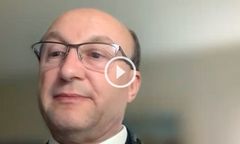
Tolerability of Teclistamab Improved with Step-Up Dosing

In a discussion with Targeted Oncology, David Dingli, MD, PhD, looks at how the use of step-up dosing with tecalistimab helped avoid many serious adverse events.
David Dingli, MD, PhD, professor of medicine, consultant in the division of hematology in the department of internal medicine and department of molecular medicine at Mayo Clinic, discusses the tolerability of teclistamab for patients with relapsed/refractory multiple myeloma (RRMM) and dosing practices with the bispecific antibody.
Teclistamab was approved by the FDA based on the phase 1/2 single-arm, multi-cohort, open-label, multicenter MajesTEC-1 study (NCT03145181), which showed heavily pretreated patients with RRMM had deep and durable responses to the drug.
The main outcome was looking at the overall response rate (ORR) in 165 patients who were pretreated with at least 3 lines of therapy. Patients were given a weekly subcutaneous injection of teclistamab at a dose of 1.5 mg/kg based on body weight after they received step-up dosing of 0.06 mg/kg to 0.3 mg/kg.
After a median follow up of 14.1 months, the ORR in the entire population was 63.0% with 65 patients achieving a complete response or better with the drug. Further, 44 patients had no minimal residual disease (MRD) at the time of follow-up, with a MRD negativity rate of 46% among those patients who had a complete response or better.
A median progression-free survival of 11.3 months (95% CI, 8.8-17.1) was also observed. The most common adverse events (AEs) were cytokine release syndrome (72.1%), neutropenia (70.9%), anemia (52.1%), and thrombocytopenia (40.0%). According to Dingli, these were manageable through step-up dosing methods and were not seen at a high grade, along with being able to use G-CSF (granulocyte-colony stimulating factor) to treat these patients.
TRANSCRIPTION:
0:08 | With step-up dosing, the incidence of toxicities is quite mild. Cytokine release syndrome occurs, typically, after the first few injections. We give the lowest dose on day 1, subsequently another dose on day 3, and by day 5 or day 7 we will give the third dose, which is the 1.5-mg/kg dose. And patients then go on to weekly therapy, as per the label. As I mentioned, the patients tolerate the drug quite well. Where I practice, [we] typically treat patients in the outpatient setting. If the patient develops fever, [we] presume it's cytokine release syndrome, and that can be treated, and we'll address that in a little bit [for them].
0:53 | Apart from the risk of cytokine release syndrome, the risk of neurotoxicity appears to be quite low and generally short-lived; it's typically grade 1 or grade 2 at most. There are some other toxicities as reported in this study, and most of these are hematologic. Typically [they are] cytopenias, whether it's anemia, neutropenia, or thrombocytopenia. The [AEs] are reversible, either by holding therapy for some time, and of course, it's important to always look for other potential causes of cytopenias, in particular, CMV [cytomegalovirus] reactivation. The neutropenia also responds very nicely with the use of G-CSF.











































